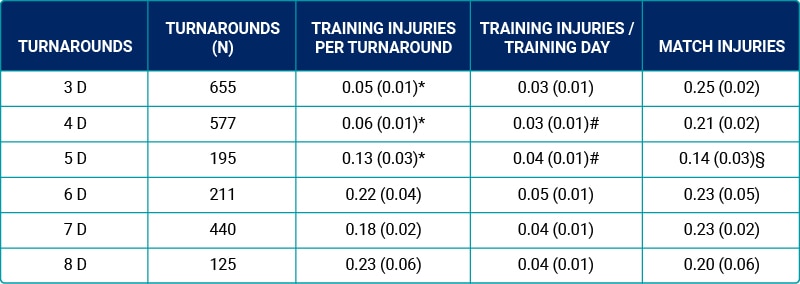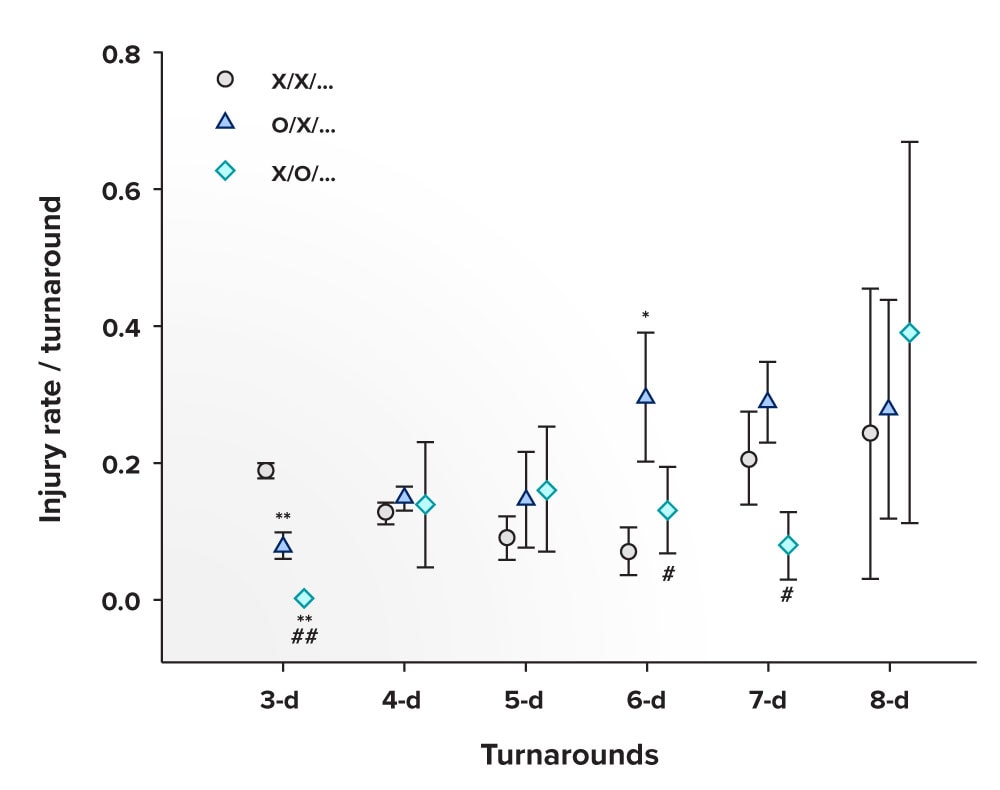By Dr. Martin Buchheit, Head of Performance Research, Maxime Settembre, Data Scientist, Karim Hader, Performance Strategist and Dr. Derek McHugh, Head of Data Science
Today, we look at a really interesting topic with no easy answer: planning the microcycle in elite football. More specifically, the association between the programming of days off (i.e., no pitch training, days off-feet) within turnarounds of varying length and its impact on the injury rate in elite soccer.
While some studies exist on programming practices in soccer, they are generally representative of single club practices dynamics or are based on periodization guides such as those first developed by R. Verheijen (The Original Guide to Football Periodisation, 2014). In our latest research paper, we set out to provide some practical recommendations and strategies that can help guide clubs to plan their weeks.
Surveying Practitioners in Elite Football
We surveyed 100 elite practitioners working in pro football to better understand the reasoning behind the choice and the drivers for planning and content selection.
The large majority of the responders confirmed that balancing work and recovery from one day to the next across the microcycle was likely required for optimized health and performance.
However, the question of whether to put players at complete rest for one or two days and its effect on injury rate during the same microcycle and the following match is still unknown.
In our latest research paper, we look at the association between the programming of days off and injury rate, using anonymized data from 18 elite teams including the EPL, the Italian Serie A, the Bundesliga, the Scottish Premiership, the MLS and the Dutch Eredivisie from January 2018 to December 2021.
The new paper is titled ‘Planning the microcycle in elite football: to rest or not to rest?’ and is currently undergoing peer review. In it, we go into detail on our approach and methodology and provide findings on the ideal programming associated with the lowest overall non-contact injury rates.
Until the published paper is available, here is a quick summary of the research:
Key assumptions:
- A n-d turnaround was defined as a microcycle with n days between the first and second match, where n is the count of days from the first day after a match up to and including the following match day. The shortest observed turnaround was 3 days (3-d) e.g., playing a match on Sunday and again the following Wednesday, while the longest was 8 days (8-d).
- Our focus was on injuries that substantially impact training and match participation so we only considered injuries that caused a minimum of 3 days of training/playing interruption i.e., ≥3-day time loss.
- The final analysis looked at the distributions of days off-feet patterns, or programming sequences, and their association with training and match injuries.
- Injuries were presented both per turnarounds and per actual training days only.
Key findings:
- Overall, injury rate was 5 times greater during matches than training, with no difference between turnaround lengths, except for the 5-d turnaround which displayed fewer injuries than all the others (Table 1).
Table 1. Number of observations for each turnaround length, and associated overall training and match injury rate (irrespective of the presence of days off or not, both contact and non-contact injuries together). *: small substantial difference vs. 5- to 8-d turnarounds. #: small substantial difference vs 6-d turnarounds. §: small substantial difference vs all other turnarounds.
- During 3- and 7-d turnarounds, the sequences including the day off-feet at D+2 were associated with 2 to 3 times lower overall non-contact injury rates than the other programming sequences (large-to-very large Cohens’ d) (Figure 1).
- For the other turnarounds, the differences between the sequences were unclear.
Figure 1. Average (95% CI) total (training + match) non-contact injury rate per turnaround for the three main sequences including either no day off (x/x/…), or a unique day off either at D+1 (o/x/…) or D+2 (x/o/…) for all turnarounds. * and ** stands for moderate and large differences vs x/x/… sequence, respectively. # and ## stands for moderate and large differences vs o/x/… sequences, respectively.
Conclusion: While association doesn’t imply causality, programming a day off (or at least ‘off-feet’) at D+2 may be a relevant strategy to decrease the incidence of non-contact injuries, especially during 3- and 7-d turnarounds.
To our knowledge, this is the first study to examine the association between the programming of day(s) off (at least days ‘off-feet’) within the training microcycle, and both training and match injury rates.
We are excited by the findings, but realize that all research has its caveats and limitations. We discuss many of these finer points in the paper but of course, we welcome your perspective and comments.
If this topic is of interest to you, we encourage you to look at three other research papers related to injury risk, which are part of an on-going series on this topic and can be found at the Performance Intelligence Research Initiative.





 More than Equal’s mission is to close the gender gap in motor sports and find and develop the first female Formula 1 world champion. They will now have an advanced operating system to centralize data for female drivers participating in More than Equal’s pioneering Development Programme.
More than Equal’s mission is to close the gender gap in motor sports and find and develop the first female Formula 1 world champion. They will now have an advanced operating system to centralize data for female drivers participating in More than Equal’s pioneering Development Programme.